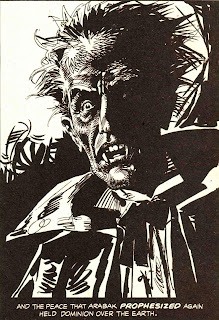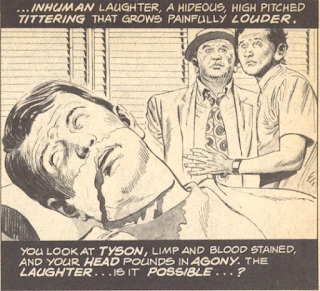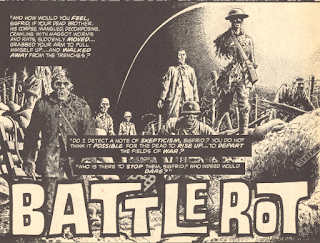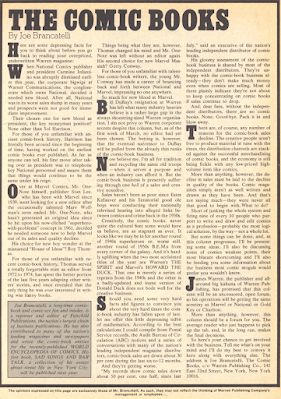The Critical Guide to
the Warren Illustrated Magazines
1964-1983
by Uncle Jack
& Cousin Peter
 |
| Torres |
"Dr. Wrighter's Asylum of Horror"★1/2
Story by Bill DuBay
Art by Gonzalo Mayo
"The Beauty and the Beast"★1/2
Story by Bill DuBay
Art by Gonzalo Mayo
"The House at Blood Corner"★★
Story by Gerry Boudreau
Art by Ramon Torrents
"Stake-Out!"★★
Story by Gerry Boudreau
Art by Jose Ortiz
"The Segerson Experiment"★★
Story by Gerry Boudreau and Steve Clement
Art by Zesar
Vampirella and Pendragon have just finished a "gig" in Aspen, Colorado, and happen upon "'Professor Widgeon's world reknown seminary of circus stars and vaudevillian performers,'" according to Pendragon, who recalls being sent there to study magic when he was a boy. The pair tour a carnival being held on the premises and, to Pendragon's surprise, see that there is now a freak show. Running it is Dr. E.C. Wrighter, who explains that he operated on "'social derelect'"s and turned them into freaks so they could make a living with the carnival. Vampi agrees to dine with Wrighter, unaware that his seemingly handsome face masks a monstrous countenance.
The freaks complain that Wrighter's promises of fame and fortune have not come true and he proclaims that he plans to graft Vampi's head onto a monstrous body and vice versa in order to sell her to Flashman Howell as a new movie star. At dinner, Wrighter drugs Vampi, but before he can operate on her the freaks turn on him. Vampi turns into a bat, sucks the blood from the freaks, and flies off.
Where to begin with this godawful mess? "Dr. Wrighter's Asylum of Horror" is Bill DuBay's "homage" to any number of things, including Dr. Terror's House of Horrors, a terrific film that bears no relation to this story. The lettering and proofreading are worse than ever and the bad in-jokes all fall flat. On a page where Vampi's bust is front and center, Pendy says he studied under "'Juggins the Great.'" "E.C. Wrighter" is a mix of E.C. Comics and Easy Rider. Vampi quips that people never notice her attire. And so on, and so on. None of it is funny. Perhaps worst of all is Pendy's comment, when explaining cotton candy to Vampi, that it is "'grown with loving care on plush plantations and hand-picked by song-in-the-heart, rhythm-in-the-feet darkies!''" In 1976? Seriously?
A movie producer named Enrique Whitestaff is having trouble finding just the right woman to co-star with Flashman Howell in a new horror movie, but when he sees Vampirella perform in a televised act with Pendragon, he knows he's found his new star! No one knows that Flashman is actually a hideous monster who wears heavy makeup to look like a handsome guy. The producer meets Vampi and explains the plot of his proposed film, but when Vampi hears it she thinks he's an agent of Chaos and puts the bite on him.
Surprisingly, "The Beauty and the Beast" picks up where this issue's first story left off. Unfortunately, it's no better than what precedes it. The corny jokes continue (an actress is called "Miss Melonbosom"), as does Mayo's habit of posing Vampirella in each panel as if it's a pinup rather than part of a story. Like E.C. Wrighter, Flashman Howell is a creature who pretends to be good looking. And on it goes. At least there's some recognition of prior stories when Vampi suspects Howell of being a disciple of Chaos--too bad the story comes to a sudden end when she goes on the attack.
Thorison House, "The House at Blood Corner," is haunted by the ghost of Paul Thorison, a decadent silent film star who supposedly was walled up alive in the house. His spirit has driven crazy everyone who tried to live there in the years since his disappearance. Now film historian Gerald Novak and his wife Christine have moved in so that Gerald can write a biography of Thorison. During their first night at the house, they see and kill a rat whose body disappears. The next night, Gerald discovers that Thorison is alive and has been behind the hauntings that killed prior residents. Sadly for Thorison, Christine is the daughter of one of his victims, and she ends his desire for fame (and Gerald's desire for cash) with two bullets.
At least none of the characters' faces melted off in this story. It's not a bad little haunted house noir, though the art by Torrents isn't particularly strong--his characters often look like swipes from photos.
In the future, vampires are called "Inheritors" and General Shorr oversees the funding of a nuclear vampire slayer, despite a truce that exists between humans and Inheritors. An Inheritor is killed in an ambush, then a human Patriarch is killed and found to have puncture wounds in his neck, so the Inheritors are blamed. The Inheritors turn into bats and fly to a Patriarch's mansion; one gets inside and wants to talk. General Shorr and his security force break in and are confronted by the Patriarch and the Inheritor, who explain that they have uncovered the truth--Shorr faked the death of the Patriarch and made it look like an Inheritor was to blame. The proof? The dead Patriarch did not rise as an Inheritor, so he could not have been the victim of a vampire. The uneasy truce remains in place and the leader of the Inheritors is allowed to feast on the treacherous general.
The clever plot twist at the end of "Stake-Out!" makes it the best story in this issue so far, despite the creaky science fiction and horror elements of this tale. Ortiz's art has been better, but at least the characters are interacting with each other, unlike in the Mayo stories.
A young woman reporter arrives at the spooky New England mansion of Randolph Segerson, where she plans to research a feature story on the reclusive writer some have called the new Poe. The author is younger than expected and shows her to her room, where she finds a bed of nails. A hooded man wielding a branding iron appears at the door to her room but leaves. Later, she spends the night in Segerson's bed because she's afraid to be alone. At lunch the next day, she first sees Segerson's head on a platter and then her own head in its place. Finally, she is chained in the dungeon and told she is to be sacrificed to an ancient horror. In the end, she is set free, having helped Segerson understand the nature of fear.
"The Segerson Experiment" is a tedious story to read, mainly because it features numerous panels of ponderous prose that is supposed to be a story written by Segerson. The art, like all of the art in this issue, is mediocre, and the story veers from one tepid terror to the next without ever generating interest or suspense. It is reminiscent of a Gothic paperback novel.-Jack
Peter-Is it just me or does Mayo's art on "Dr Wrighter" look as if editor Weezy Jones cut and pasted a whole lot of Mayo art and glued them together on storyboards? No, it's not just me, cuz the evidence is right there on the pages. None of this looks right (never mind the fact that half the support and background characters look like Famous Monsters stills); there's no flow or synch whatsoever. Characters appearing in the same panel don't even seem to look at each other when they're speaking. Nor is there any cohesion to the script, an ugly, rambling mess that hits all the Vampi-series buttons and leaves you wondering (as did the previous chapters) why we do what we do in our free time. Incredibly enough, the follow-up, "The Beauty and the Beast," is even worse. I get that the very idea of a Vampirella series necessitates a Fugitive-style narrative, but if Dube intends to stick to that template he'd better find a way to add some depth and originality or I'll keep calling a turd "a turd."
Which is a great segue into Gerry Boudreau's "The House on Blood Corner," a potboiler that begins as a ripoff of Richard Matheson's Hell House and then transforms into something altogether more ludicrous halfway through. I couldn't stop chuckling as goofy expositories were laid atop each other like samples in some unholy shag carpet warehouse. I mean, it makes perfect sense that the horror movie director got so pissed at his unloving public that he faked his own death and spent a fortune on building the legend of his haunted house, right? But no, wait, it gets better. The writer's wife is the daughter of the guy who died of fright years before! My knee is black and blue from the slapping.
The drivel just keeps on coming with Gerry's "Stake-Out" and "The Segerson Experiment." The former is a needlessly complicated yawner almost saved by Ortiz's spare but effective graphics and the latter is a head-scratcher with an eye-rolling climax. Judging by the samples of Randolph Segerson's writing (Putrid odors from nearby swamplands hung like Christmas stockings over the grounds... His eyes were yellow, the pale color of weasel urine...), I wouldn't be surprised if Louise Jones hadn't already signed the man to an exclusive Warren contract.-Peter
 |
| Kelly |
"Brannigan's Gremlins" ★★1/2
Story by Bill DuBay
Art by Luis Bermejo
"Wings of Vengeance!" ★★
Story by Bill DuBay and Esteban Maroto
Art by Esteban Maroto
"The War!" ★
Story by Roger McKenzie
Art by Paul Neary
"Close Shave" ★
Story by Roger McKenzie
Art by Martin Salvador
"Battle Rot" ★★★
Story by Bill DuBay
Art by John Severin
"Billicar and the Momblywambles of Glass" ★
Story by Steve Clement
Art by Isidro Mones
During World War I, a fighter pilot discovers the planes in his squadron house pipsqueak nuisances known as "gremlins." The other pilots explain that there is no explanation for the little devils and that there are "good gremlins" and "bad gremlins," the latter of which are capable of tearing a plane apart and sending a pilot to an early grave.
There's really not much to "Brannigan's Gremlins," but I found the fantasy an enjoyable bit of fluff, with Dube ratcheting down the poetry and just telling a fireside story for once. The art is adequate, but unlike, say, George Evans's classic dogfights from the EC Two-Fisted/Frontline days, the plane battles look like Luis simply drew a batch of sideways Fokkers (pardon my German). But it's the whimsical element of this one that sells it.
A young man sits in the forest and recounts his tale of sorrow to the birds that sit nearby in rapt attention. Once he was the handsome son of a warrior, until he attempted to covet his father's young bride-to-be. Enraged, his father put the girl to death and had his son mutilated and cast into the forest. The man wonders if the birds can understand his sorrow, never knowing they've evened the score.
Can we agree that every beautiful young man Maroto ever drew looks the same? I'll grant you there's still some of that Esteban magic evident in the cliched and flowery "Wings of Vengeance!" but, overall, it's pretty plain by 1976. And it always takes me at least 75% longer to read a DuBay scripted story than anyone else's; I have to constantly re-read a sentence to see if it really makes sense or not (The sun's brightness wained [sic] as I watched my love's fearful tears. And yet I was too cowardly to stand against my sire. That, or truly did I love him and wished not to betray him).
In a way-too-familiar future, a warrior hunts down vampires and zaps one with his laser-beam gun but, as we discover, the real enemy of man is... woman! "The War!" is a needlessly complicated and pretentious sci-fi tale that lost me by its second panel. It might seem to our readers as though I'm an endlessly grumpy old man who really hates comics and, in particular, Warren comics but, in reality, I'm just looking for something readable and (if I can find it) original. These Warren sci-fi strips are the furthest from original you can find, gobbed up with long, poetic sentences (He wondered how it had come to this. But he didn't have any answers. He was only a soldier. A killing machine. And he was tired as hell...!), written at lunchtime on napkins in the Warren cafeteria by bored mail room interns and "rescued" by McKenzie/DuBay/Moench/ Lewis for all eternity. And what's with the throwaway reference to vampires? What does that have to do with the war between men and women (ooooh, there's a hot button topic, right?) in this goofy version of the future? With the Neary art, it's also a little too close to "Hunter," wouldn't you say?
Jack-It's sad when a text column is the highlight of an issue of comics, but that's the case here. I was floored by Brancatelli's honesty and the way he went after some of the industry's sacred cows. I was also surprised to see he was editor at Fairchild Publications, the site of my first job after college.
 |
| Zzzzzzz |
Eddy the barber gives a real "Close Shave" to Mr. Tyson, whose wife has been occupying Eddy's bed of late. Eddy and Mrs. Tyson have been planning the untimely death of the Mister for quite some time; one deep thrust of Eddy's razor and the insurance money is theirs. Deed done, Eddy prepares for clean-up but then a series of mishaps leads to his undoing. This could very well be the worst story of the year in both script and art department. Though Martin Salvador's work would never have been mistaken for that of an Alcala or Bea, the artist's output by 1976 could only be charitably referred to as "output." Nothing in any of the panels found in "Close Shave" exhibits an artistic vision. It's simply there.
But that's actually more than you can say for Roger McKenzie's script, which comes off as a light bulb that went on over Roger's head after he read a couple of the East Coast Comix reprintings of Tales from the Crypt. As with the goofy three-panel mention of mutant vampires in "The War," Roger drops in a quick nod to Poe's "The Tell-Tale Heart" for no apparent reason. Utter drivel.
In World War I Germany, rumors of the dead awakening on the battlefield rumble through the ranks. But these silly wives' tales do not frighten ace fighter pilot Sigfrid von Meuse; to Sigfrid, the dead are dead. His outlook on the "other side" changes when he is tasked with the mission to bomb a civilian hospital before the enemy can transport their wounded to the building. Sigfrid's plane is shot down and crashes into the infirmary, where the pilot is helped out of the rubble by what appear to be walking corpses. Sigfrid loses his mental facilities, never knowing that his plane has crashed into a hospital for lepers.
Here's what happens when DuBay tells an EC story that's simple, to the point, and has a good shock ending. Of course, it helps that Dube has EC vet Severin along for the ride. Severin's splash, depicting the victims of "Battle Rot," is gloriously disgusting (aside from that opening, we never do find out if the walking corpses are a product of fatigue or the supernatural) and elicited an ear-to-ear smile from this grizzled old war comics vet. Rotting head and shoulders; best story of the month.
Attending a private boys' school is no fun, but it can be downright dangerous when your teacher locks you in the closet for being a naughty boy and you discover the small room is actually a doorway to another world. Billy meets new friends (Quazz, the deeeelightful Koala-thingie) and horrible monsters (the scorpion-tailed dinosaurs known as Momblywambles) on his path to self-discovery and becoming a better young man.
Oh boy. Alice in Wonderland wanna-be "Billicar and the Momblywambles of Glass" is a hectic, meandering waste of paper with some genuinely irritating artwork and no sense of direction. I can't honestly say I understood the "point" here (if there's one that writer Steve Clement wanted to make, that is). Teachers are mean? Little precocious boys make the best wizards? Drugs do not make for good prep when you're attempting to write comic book strips? When in doubt, slap a Bill Dubay title on your script?
Outside of "Battle Rot," this is a fairly disposable issue of Creepy. On the plus side, we get the initial installment of Joe Brancatelli's "The Comic Books" column. Brancatelli had served as editor of the unique newspaper-formatted The Monster Times (get me started and I'll never stop talking about how much I loved TMT as a kid) and the TMT offshoot, Inside Comics. Obviously, Jim Warren must have seen something in Brancatelli's critical outlook on the comics and thought it a perfect fit for the Warren zines. The column appeared in all the titles until March 1980. You can read Brancatelli's recollections of the behind-the-scenes and the abrupt end of the forum in Twomorrows' The Warren Companion. In his opener, Joe discusses the changing of the guard at Warren, DC, and Marvel and the declining sales figures of mainstream funny books. Essential reading each and every month.-Peter
As for the comics, they were pretty bad and made me wonder if another Dark Age of Warren is upon us. "Battle Rot" was best, with fairly good Severin art and a decent twist ending. "Brannigan's Gremlins" was pretty dull for a story about gremlins, and the little guys weren't drawn very clearly, even though they were the focus of the story. DuBay shows a penchant for grotesque, cruel violence in "Wings of Vengeance," and I wasn't sure at the end if the birds really attacked the old guy or not. As I read "The War," I noticed for the umpteenth time that Paul Neary sure draws a lot of people wearing helmets--it seems to me that this is because he's not very good at drawing faces. "Close Shave" had more gore and lousy art by Salvador, while "Billicar..." was just terrible from every angle. At least we have the Captain Company ads to enjoy!
 |
| Next Week... The Joker's Last Laugh! |












Well….nice covers, at least.
ReplyDeleteBrancatelli’s column was a shocker for me back in the day: ‘Hey kid, all those comics you like are CRAP!’ I was able to get past the opinionated stuff, but the harsh data about the business end of comics, especially the steadily declining newsstand sales, was truly alarming. Fortunately, it turned out that the Death Of Comics WASN’T just right around the corner, but apparently it very nearly was, around that time.
b.t.
Our opening Vampi story absolutely boasts some beautiful Gonzalo Mayo art... as for the quality of the story... not all that good. Dubay is repeating ideas here, this story seems a lot to me like one of the Coffin stories where he came across a freak show where they were creating new freaks. Freaks also is a popular subject with Warren lately as we're just coming off the Freaks series, and they were also a part of the most recent Jebediah Pan story. Time for Dubay to think of other topics to write about. The second story isn't all that better. Oh, and the whole concept of having a handsome male guest star who is actually using makeup or a mask to cover a hideous face has also been done before with Vampi. New ideas needed badly! At the very least the rest of the issue isn't too bad. "House at Blood Corner" is a clever tale with good Torrents art. "Stake Out" is an interesting concept with a "why didn't I think of that earlier?" twist at the end. Wonderful Ortiz art, although that's him with pretty much every story! Another haunted house story with "The Segerson Experiment" which doesn't interest me as much as the others although I'm always happy to see Zesar's art.
ReplyDelete"Brannigan's Gremlins" ain't a bad story, but having two World War I era plane based stories in one issue was a bit too much and as this was the one I read second it did feel kinda stale to me. George Evans could really draw a good plane story, they should have tried to get him to do one of these stories! Alas, he will never show up in the Warren pages again. "Wings of Vengeance" is a fairly good story for me at least until the ending which was rather abrupt and "eh". Did the birds really kill his dad or was he just imagining it? "The War" comes off like an Exterminator story with the design of the main character, but overall quite the cliché tale. "Close Shave" is another lackluster tale whose ending reminds me of an extremely lackluster story in the last issue of the Haunt of Fear that also used a skull as its "shock" ending. "Battle Rot" returns us to the plane subject but is the far better story with some good Severin art and a nice twist ending that I wasn't expecting. "Billicar" is just an overall mediocre story, I've had about enough of these whimsical stories in the Warren pages by this point (such as the Gilliam Taxi story we got a month or two ago) and Mones' art is quite poor for him. Mones was one of Warren's best artists for a while there but his art has deteriorated a bit and this will be his last Warren story for at least a couple of years. Alas when he finally returns his art looks even worse.
That one panel of "Brannigan's Gremlin's" makes me wonder whether it was inspired by THE ABOMINABLE DR. PHIBES as much as those "pilot and gremlin" traditions. It reminds me of those rats in the man's plane.
ReplyDeleteWhatever else might be wrong with Vampirella # 52, I think it has one of the great covers.
(At least if you have a certain preoccupation.)
I think that Vampi cover is great, period, whether one is especially into big boobs or not :) — the pose, the composition, the color (even the unusual pastel pink on the logo and text works really well in contrast to the gold / bronze pallette ), etc. I don’t know if it was totally intentional or not, but the scalloped shapes at the bottom fringe of her hair look vaguely like bat wings, too. Love it.
ReplyDeleteb.t.
Yes, that's true too.
ReplyDeleteThat is a good cover. Too bad the interiors aren't up to its level.
ReplyDelete